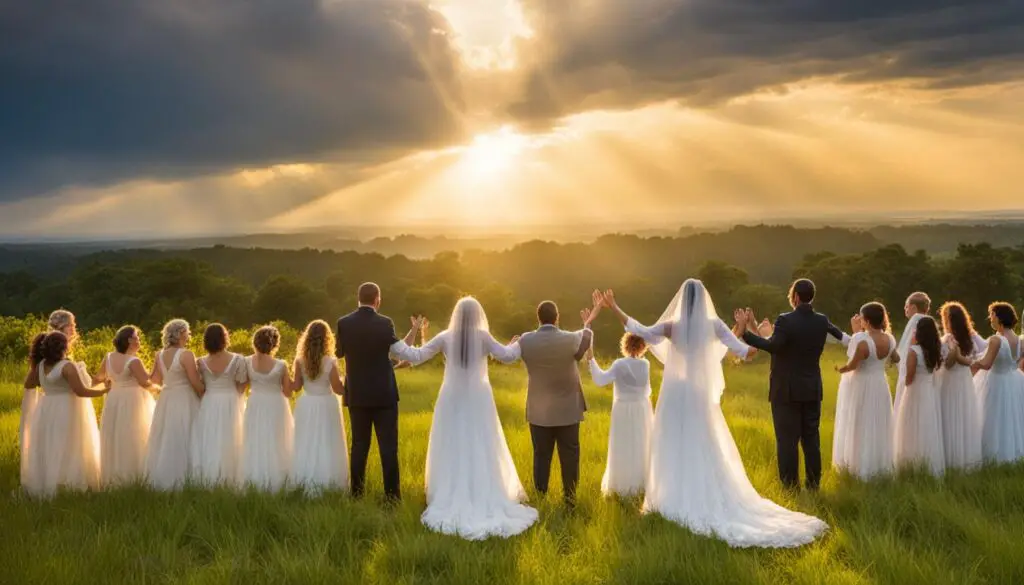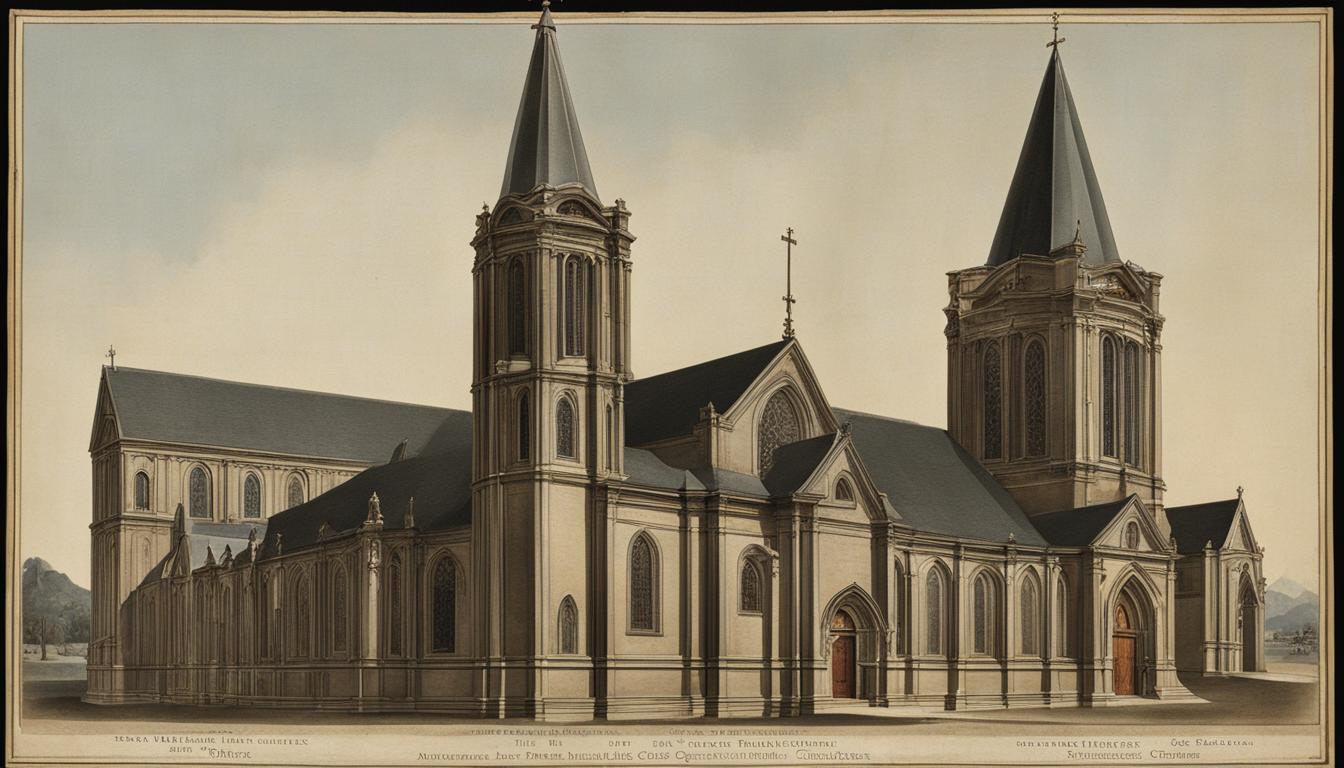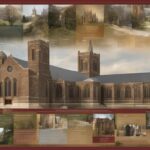The concept of the Bride of Christ is deeply rooted in Christian symbolism and biblical references. It represents the spiritual union between Christ and His church, with the church often referred to as the bride. This metaphor of a wedding emphasizes the intimate and transformative relationship between Jesus and His followers, highlighting the depth of love and commitment. Salvation is seen as the ultimate act of divine love, and faith and discipleship are embraced as a transformative journey towards this union with Christ.
Throughout history, the belief in the Bride of Christ has shaped Christian theology and practices. It has influenced the way believers understand their relationship with Jesus and the church’s role in God’s plan of redemption. From sacraments and rituals to leadership and worship practices, the Bride of Christ is a profound and enduring symbol within the Christian faith.
In this article, we will explore the origins of the Bride of Christ, delve into its theological beliefs and doctrines, examine the sacraments and rituals associated with this belief, and discuss the roles of leadership and clergy within the Bride of Christ community. We will also explore worship practices, the significance of sacred texts, the presence of this belief across different Christian denominations and sects, and the importance of community and outreach. Additionally, we will consider the architectural and artistic features that reflect the Bride of Christ symbolism and address contemporary issues and challenges faced by believers who embrace this belief in the modern world.
Join us on this journey as we delve deeper into the profound significance of the Bride of Christ and its enduring relevance in the lives of Christians today.
Key Takeaways:
- The Bride of Christ represents the spiritual union between Jesus and His church, emphasizing love and commitment.
- Salvation through Jesus is seen as the ultimate act of divine love, and faith and discipleship foster this union.
- The belief in the Bride of Christ has historical and biblical foundations dating back to early Christian communities.
- Sacraments and rituals, such as baptism and the Eucharist, play a significant role in the belief in the Bride of Christ.
- Leadership and clergy have roles in nurturing the spiritual growth of the Bride of Christ community.
History and Origins
The concept of the Bride of Christ finds its historical origins in biblical foundations and early Christian beliefs. It draws inspiration from passages in the New Testament, such as Ephesians 5:23-32 and Revelation 19:7-9, which vividly depict the church as the bride and Christ as the bridegroom. These passages capture the essence of the spiritual union between Christ and His followers, highlighting the depth of love and commitment.
Early Christian believers embraced this metaphor of a wedding, viewing themselves as the betrothed to Christ. They saw their relationship with Him as a transformative journey towards the ultimate union. The belief in the Bride of Christ gradually became a central aspect of Christian theology, permeating worship, devotion, and the understanding of salvation.

The concept of the Bride of Christ is not merely symbolic; it holds profound spiritual significance for believers. It serves as a reminder of our divine relationship with Christ and the transformative power of His love.
Beliefs and Doctrines
The belief in the Bride of Christ encompasses theological beliefs about the spiritual union between Christ and His church. It is rooted in the profound understanding that God’s love is transformative and redemptive, offering salvation to all who seek it. This belief highlights the divine love and grace that flow through the union between Christ, the Bridegroom, and the church, His Bride.
Central to the belief in the Bride of Christ is the acknowledgment that humanity, created in God’s image, is in need of redemption. Through His sacrificial love, Jesus Christ provides the means for this redemption, offering salvation and eternal life to those who believe in Him. This belief instills a sense of hope and purpose in the hearts of believers, as they strive to grow in love, holiness, and oneness with their Bridegroom.
As recipients of God’s grace and salvation, Christians who embrace the belief in the Bride of Christ are called to cultivate a deep and intimate relationship with Christ. They seek to align their lives with His teachings and character, allowing the transformative power of His love to shape their thoughts, actions, and desires. This spiritual union with Christ becomes the foundation for a life of discipleship, marked by obedience and a growing resemblance to the Bridegroom Himself.
“For God so loved the world, that he gave his only Son, that whoever believes in him should not perish but have eternal life.” – John 3:16
The belief in the Bride of Christ inspires believers to embody divine love in their relationships with others. It calls them to extend compassion, forgiveness, and grace, mirroring the selfless love exemplified in Christ’s sacrifice. This belief also emphasizes the importance of unity and harmony within the church, as the Bride is called to be a collective witness to the transformative power of God’s love.
Ultimately, the belief in the Bride of Christ points to the fulfillment of God’s redemptive plan for humanity. It signifies the longing for the day when the Bridegroom will return and the Bride will experience the fullness of their spiritual union in the eternal presence of God. Until that glorious day, believers are invited to embrace the journey of faith, holding steadfast to the promise of redemption and growing in love as they await the consummation of their union with their Bridegroom, Jesus Christ.

Symbolism in the Belief of the Bride of Christ
| Symbol | Meaning |
|---|---|
| Wedding | The intimate union between Christ and His church |
| Bridegroom | Christ’s sacrificial love and leadership |
| Bride | The church, embracing the transformative power of divine love |
| Redemption | Salvation through Jesus Christ’s sacrificial death |
| Divine Love | The unconditional and selfless love of God |
Sacraments and Rituals
Within the context of the belief in the Bride of Christ, sacraments and rituals hold profound significance. These sacred acts serve as tangible expressions of our devotion and commitment to our Bridegroom. Let us explore two pivotal sacraments that strengthen our connection to the Bride of Christ: baptism and the Eucharist.
Baptism:
Baptism is a transformative rite of initiation into the community of the Bride. It symbolizes the spiritual rebirth and the believer’s commitment to follow Christ wholeheartedly. Through baptism, we are cleansed of sin and clothed in the righteousness of Christ, symbolically joining the Bride in her journey towards unity with the Bridegroom.
The Eucharist:
The Eucharist, also known as Holy Communion, is a sacred and symbolic act of unity with Christ and our fellow believers. In partaking of the bread and wine, representing the body and blood of Christ, we proclaim our oneness with the Bridegroom and affirm our connection to the broader community of the Bride. Through this sacrament, we are nourished spiritually and reminded of the intimate relationship between the Bride and her Bridegroom.
These sacraments are not merely symbolic acts but powerful channels through which we experience the divine presence and grace of our Bridegroom. They strengthen our commitment to the faith and deepen our connection to the Bride of Christ, supporting us in our journey as faithful disciples.

Leadership and Clergy
The belief in the Bride of Christ has a profound impact on church leadership and the roles of clergy. Within the metaphorical framework of the Bride, those in leadership positions assume the roles of shepherds or stewards, entrusted with the responsibility of guiding and nurturing the spiritual growth of the community.
The clergy, including pastors, priests, and ministers, play a vital role in fostering the spiritual union between the Bride and her Bridegroom. They provide pastoral care, teach the tenets of faith, and offer guidance in navigating the transformative journey towards a deeper relationship with Christ.
The Role of Church Leaders
Church leaders, as shepherds of the Bride, exemplify the qualities of servant leadership. They strive to lead by example, emulating the sacrificial love and selflessness exemplified by Jesus Christ.
“A good shepherd lays down his life for the sheep.” – John 10:11
Their primary focus is on the spiritual well-being and growth of the community, ensuring that each member of the Bride of Christ is nurtured and supported in their faith journey.
Pastoral Care and Guidance
Pastors, priests, and ministers provide pastoral care to the members of the church, offering guidance, support, and comfort during times of joy and sorrow. They are the spiritual shepherds who walk alongside their congregations, helping them navigate the challenges of life while keeping their focus on the eternal union with the Bridegroom.
Through teaching and preaching, they equip the Bride of Christ with the necessary knowledge and understanding to deepen their relationship with Christ and live out the principles of faith in their daily lives.
Empowering the Bride
Church leaders empower the individual members of the Bride by encouraging them to discover and utilize their spiritual gifts and talents. They create an environment that fosters growth, discipleship, and active participation in the life of the church community.
By recognizing and affirming the unique calling and purpose of each member, church leaders support the Bride of Christ in fulfilling its collective mission of spreading the love and message of Jesus Christ to the world.

Church leadership plays a vital role in nurturing the spiritual growth of the Bride of Christ. The clergy’s unwavering commitment to guiding and empowering the community ensures that the deep spiritual union between the Bride and her Bridegroom is cultivated and strengthened.
Worship Practices
Worship is at the heart of the belief in the Bride of Christ, as believers come together to honor and adore their Heavenly Bridegroom. Through singing, prayer, and various forms of worship, the Bride expresses her deep love and devotion to Christ, celebrating the divine union they share.
Singing holds a prominent place in the worship practices of the Bride of Christ. Hymns and songs resonate with the themes of love, union, and commitment to Christ, allowing believers to express their heartfelt praise and adoration. The power of music ignites the spirit, uplifting the souls of worshippers and creating an atmosphere of reverence and awe in corporate worship gatherings.
Prayer is another vital element in the worship practices of the Bride of Christ. Through prayer, believers communicate with their Bridegroom, pouring out their hearts, seeking His guidance, and aligning their lives with His divine will. Prayer deepens the relationship between the Bride and Christ, fostering intimacy and trust.
Corporate worship gathers believers as one, allowing them to unite as the Bride of Christ. These collective worship experiences create a sense of community and shared devotion, reinforcing the spiritual bond among believers. As they worship together, the Bride supports and encourages one another on their journey of faith, reminding each other of their ultimate union with Christ.
“Let the word of Christ dwell in you richly, teaching and admonishing one another in all wisdom, singing psalms and hymns and spiritual songs, with thankfulness in your hearts to God.” – Colossians 3:16
As the Bride of Christ, believers are invited to wholeheartedly engage in worship, offering their praise, thanksgiving, and adoration to the Bridegroom. Through worship practices, the Bride expresses her love, commitment, and longing for her eternal union with Christ.

Worship Practices of the Bride of Christ:
- Singing hymns and spiritual songs filled with themes of love and commitment to Christ
- Prayer as a means of communication and connection with the Bridegroom
- Collective worship gatherings to unite as the Bride and support one another
- Praising and adoring God through various forms of worship
- Expressing gratitude and thanksgiving to the Bridegroom in worship
Sacred Texts
The belief in the Bride of Christ is deeply rooted in the sacred texts of the Bible, which serves as the ultimate guide and source of wisdom for believers. Throughout both the Old and New Testaments, there are numerous passages that provide biblical teachings and scriptural references to support and shape the understanding of the Bride of Christ.
“Let us rejoice and be glad and give him glory! For the wedding of the Lamb has come, and his bride has made herself ready.” (Revelation 19:7)
“For the husband is the head of the wife as Christ is the head of the church, his body, of which he is the Savior. Now as the church submits to Christ, so also wives should submit to their husbands in everything. Husbands, love your wives, just as Christ loved the church and gave himself up for her…” (Ephesians 5:23-25)
These passages, among many others, emphasize the importance of the Bride of Christ and the deep spiritual union between Christ and His church. They provide a framework for believers to deepen their understanding of their relationship with Christ as His Bride and inspire them to embrace the transformative journey of faith and discipleship.
| Scriptural References | Teachings |
|---|---|
| Revelation 19:7-9 | Describes the joyous wedding of the Lamb and His bride |
| Ephesians 5:23-32 | Highlights the submission, love, and sacrifice within the relationship between Christ and His church |
| Isaiah 62:5 | Portrays the love and delight that God has for His people, equating it to the love between a bridegroom and his bride |
| Matthew 25:1-13 | Uses the parable of the ten virgins to illustrate the need for readiness and preparation as the Bride of Christ |
These scriptural references provide a solid foundation for the belief in the Bride of Christ, offering insight into the divine plan for salvation and the extraordinary love that God has for His people. They serve as a guide for believers, shaping their understanding of their identity as the Bride and inspiring them to live out their faith with devotion and holiness.
Denominations and Sects
The belief in the Bride of Christ is embraced by various Christian denominations and sects, each with their own interpretations and theological differences. These diverse perspectives contribute to a rich tapestry of understanding and worship within the broader Christian faith.
Christian denominations, such as Catholicism, Eastern Orthodoxy, and Protestantism, each approach the concept of the Bride of Christ through their unique theological lenses. While the foundational belief in the spiritual union between Christ and His church remains consistent, the emphasis and nuances can vary.
Sectarian Interpretations
Within denominations, sects may emerge with specific interpretations of the Bride of Christ. These sects often form around charismatic leaders or distinct theological viewpoints. They may place greater emphasis on certain aspects of the belief, such as personal holiness or eschatological perspectives.
“In our sect, we believe that the Bride of Christ represents the true, faithful remnant of believers who will be united with Christ in the end times, and we actively prepare for this spiritual union through fervent prayer, righteous living, and evangelism.” – Pastor Michael, leader of a charismatic sect.
Theological Differences
Theological differences regarding the Bride of Christ can arise from variations in interpretation of specific biblical passages or from broader theological frameworks. These differences may influence teachings, worship practices, and the overall understanding of the believer’s role as part of the Bride.
For example, some denominations may focus more on the eschatological aspects of the Bride – anticipating the future union with Christ in the heavenly realm. Others may emphasize the present reality of the Bride, encouraging believers to actively participate in the redemptive work of Christ in the world.
Unity Through the Bride
Despite these theological differences and varying interpretations, the belief in the Bride of Christ serves as a unifying symbol across Christian denominational boundaries. It is a reminder of the central message of the gospel – the love of Christ and the redemption offered through faith in Him.
Regardless of denominational affiliations, Christians can find common ground in their shared identity as members of the Bride. This unity allows for collaboration, mutual understanding, and the celebration of diverse expressions of faith within the body of Christ.
Through the image of the Bride of Christ, believers are encouraged to reflect on their own relationship with Christ and their role as part of the larger church community. It serves as a reminder that, despite denominational or sectarian divides, all followers of Christ are united in their pursuit of divine union and the embodiment of His love in the world.
Community and Outreach
The belief in the Bride of Christ underscores the significance of community and outreach in the lives of believers. As cherished members of the Bride, we are called to embody the love of Christ and extend it to others through acts of service and compassion. This involves reaching out to those in need, both within and beyond the church walls, and sharing the transformative message of God’s love and salvation.
“By this everyone will know that you are my disciples if you love one another.” – John 13:35
As followers of Christ, we strive to emulate His love for others and serve as a beacon of hope in a world that often feels lost and broken. By engaging in outreach efforts, we actively demonstrate Christ’s love through acts of kindness, justice, and mercy.
Our outreach initiatives extend a helping hand to the marginalized, oppressed, and vulnerable members of society. We believe that by serving others, we fulfill our purpose as the Bride of Christ and manifest His love in tangible ways.
Outreach Programs:
Our community outreach programs encompass a wide range of initiatives that address various social issues, bringing hope and healing to those in need:
- Providing food and clothing to the homeless
- Partnering with local organizations to offer educational resources to underprivileged children
- Supporting women’s shelters through donations and volunteer work
- Visiting the elderly and offering companionship
- Advocating for justice and equality in our communities
Through these acts of service, we aim to shine the light of Christ and demonstrate His love for all people. Our desire is to create a community where everyone feels valued, loved, and cared for, regardless of their background or circumstances.
| Benefits of Community and Outreach | Impact |
|---|---|
| Building strong relationships within the church community | Strengthened unity and support |
| Fostering a sense of belonging and purpose | Increased engagement and commitment |
| Spreading the message of God’s love and salvation | Transformation and hope for those who hear |
| Addressing social injustices and meeting tangible needs | Positive change in individuals and communities |
Architectural and Artistic Features
In the belief of the Bride of Christ, architectural and artistic features play a significant role in expressing the profound spiritual connection between Christ and His church. Church buildings and artwork are adorned with symbolic elements that convey spiritual truths and invite contemplation.
Symbolic Elements:
Stained glass windows, paintings, and sculptures often depict the union between Christ and His church. These artistic representations serve as visual reminders of the deep love and commitment between the Bridegroom and His Bride. They convey spiritual truths in a tangible and captivating way, sparking reflection and inspiring awe in worshippers.
Design and Layout:
The design and layout of church buildings themselves may incorporate symbolic elements that highlight the significance of the Bride of Christ. From grand entrances to soaring spires, every architectural feature can be intentionally crafted to elicit a sense of reverence and reflect the divine union that the Bride represents.
Contemporary Issues and Challenges
The belief in the Bride of Christ faces various contemporary issues and challenges in the modern world. As societal changes impact cultural norms and values, the relevance and understanding of this metaphor may evolve. Christians must navigate how to effectively communicate and live out the belief in the Bride of Christ in a changing cultural landscape, while remaining faithful to the core principles and teachings of their faith.
In an increasingly secular society, the concept of the Bride of Christ may be seen as archaic or irrelevant to some. The challenges lie in presenting this belief in a way that resonates with the hearts and minds of individuals in modern culture. It requires a thoughtful and relatable approach that addresses the concerns and questions raised by contemporary society.
Societal changes also bring about new perspectives and interpretations of relationships, gender roles, and marriage. This presents an opportunity to engage in meaningful conversations about the Bride of Christ and its relevance to the understanding of love, commitment, and spiritual union. Christians can explore how this metaphor speaks to the complexities of human relationships and ultimately points to a deeper spiritual reality.
The belief in the Bride of Christ remains an enduring symbol within Christian theology and worship, despite the challenges posed by societal changes. The metaphor continues to offer a profound understanding of the divine relationship between Christ and His church, reminding believers of their identity, purpose, and the call to grow in holiness and love.
Embracing the relevance of the Bride of Christ in modern culture requires a delicate balance between preserving the rich traditions and interpretations of the past and effectively communicating its timeless message in a way that speaks to the current generation. It involves thinking creatively and innovatively about how to present the deep truths of this belief in the face of changing cultural norms.
Engaging with contemporary issues through the lens of the Bride of Christ can provide a unique perspective and vital contribution to discussions surrounding topics such as marriage, gender, identity, and human flourishing. Christians are called to be ambassadors of the transformative power of the Bridegroom’s love and to offer a compelling vision of unity, redemption, and eternal hope.
Conclusion
The belief in the Bride of Christ is a profound spiritual concept that invites believers to embark on a transformative journey of faith and discipleship. It serves as a powerful symbol of the deep love and union between Christ and His church, reminding believers of their divine relationship and the call to cultivate holiness and love in their lives.
Throughout history, the Bride of Christ has been a central theme in Christian theology and worship. Its origins can be traced back to biblical foundations and early Christian beliefs, and it continues to be upheld as a fundamental tenet of faith across various denominations and sects.
The belief in the Bride of Christ finds expression through sacraments and rituals, such as baptism and the Eucharist, which symbolize the believer’s initiation into the spiritual union with Christ and their ongoing communion with Him. Church leadership and clergy play crucial roles as shepherds, guiding and nurturing the growth of the community as they navigate the transformative journey towards union with the Bridegroom.
Worship practices and corporate gatherings allow believers to come together as the Bride, expressing their devotion and praise to the Bridegroom through singing and other forms of worship. The sacred texts, particularly the Bible, provide the foundation for understanding the belief in the Bride of Christ and offer guidance for believers in deepening their relationship with Christ.
Despite the challenges and varied interpretations faced in the modern world, the Bride of Christ remains an enduring symbol of faith and a call to holiness. It is a representation of the profound divine love that offers believers the opportunity to grow in their spiritual journey and embrace the transformative power of their relationship with Christ.
FAQ
What is the Bride of Christ?
The Bride of Christ is a symbolic representation of the spiritual union between Jesus and His church. It emphasizes the intimate relationship between Christ and His followers, with the church often referred to as the bride.
Where does the concept of the Bride of Christ originate?
The concept of the Bride of Christ has its roots in Christian symbolism and biblical references. It can be found in passages of the New Testament, such as Ephesians 5:23-32 and Revelation 19:7-9, that describe the church as the bride and Christ as the bridegroom.
What does the belief in the Bride of Christ entail?
The belief in the Bride of Christ encompasses theological beliefs about the spiritual union between Christ and His church. It emphasizes the transformative power of divine love and the redemptive nature of this relationship, calling believers to grow in love and holiness as they journey towards ultimate union with their Bridegroom.
How do sacraments and rituals relate to the Bride of Christ?
Sacraments and rituals play a significant role within the belief in the Bride of Christ. Baptism is seen as initiation into the community of the Bride, symbolizing spiritual rebirth and commitment to following Christ. The Eucharist, or Holy Communion, represents a symbolic act of unity with Christ and fellow believers, reinforcing the spiritual union between the Bride and her Bridegroom.
What is the role of church leadership within the belief in the Bride of Christ?
Church leaders, such as pastors, priests, and ministers, are seen as shepherds or stewards of the Bride. They guide and nurture the spiritual growth of the community, fostering the spiritual union between the Bride and her Bridegroom through pastoral care, teaching, and guidance.
How is worship practiced within the belief in the Bride of Christ?
Worship practices within the belief in the Bride of Christ involve praising and glorifying God through singing, prayer, and other forms of worship. Corporate worship gatherings provide opportunities for believers to come together as the Bride, expressing their love and devotion to the Bridegroom. Singing plays a significant role, with hymns and songs often focusing on love, union, and commitment to Christ.
What role does the Bible play in the belief in the Bride of Christ?
The Bible serves as the sacred text that guides and shapes the understanding of the belief in the Bride of Christ. Passages from both the Old and New Testaments are cited to support the theological foundation of the Bride of Christ and provide a framework for believers to deepen their relationship with Christ as His Bride.
How is the belief in the Bride of Christ expressed within different Christian denominations?
The belief in the Bride of Christ is embraced by various Christian denominations and sects, although interpretations and emphasis may differ. Different theological perspectives and traditions within Christianity may emphasize specific aspects of this belief or have unique interpretations of its significance.
What is the importance of community and outreach within the belief in the Bride of Christ?
The belief in the Bride of Christ emphasizes the importance of community and outreach. Believers are called to love and serve one another, reaching out to those in need and spreading the message of God’s love and salvation. The community of the Bride extends beyond the walls of the church, actively engaging with the world and demonstrating Christ’s love through acts of compassion, justice, and mercy.
How does the belief in the Bride of Christ influence architectural and artistic features in churches?
The belief in the Bride of Christ is reflected in architectural and artistic features of church buildings. Symbolic elements, such as stained glass windows, paintings, or sculptures, often depict the union between Christ and His church, conveying spiritual truths and inviting contemplation. The design and layout of church buildings may incorporate symbolic elements that emphasize the significance of the Bride of Christ within the worship space.
What are the contemporary issues and challenges faced by the belief in the Bride of Christ?
The belief in the Bride of Christ faces contemporary issues and challenges in the modern world. As societal changes impact cultural norms and values, the relevance and understanding of this symbol may evolve. Christians must navigate how to effectively communicate and live out the belief in the Bride of Christ in a changing cultural landscape while remaining faithful to the core principles and teachings of their faith.
















